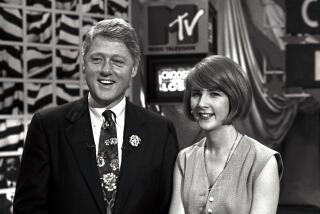Created PM Newspaper in Eventful Career : Ex-Magazine Editor Ingersoll Dies
Ralph Ingersoll, the one-time editor of New Yorker and Fortune magazines who made journalism history by launching the newspaper PM, died Friday in a Miami Beach hospital, where he suffered a stroke last week. He was 84.
Although Ingersollâs eventful career included the writing of books as well as top secret U.S. Army papers during World War II that misled the Germans about Allied invasion plans, he was best known for his creation of the New York newspaper that refused to accept advertising.
It did not survive, despite his postwar attempts to save it. He left the dying PM in 1946 in a falling-out with then-owner Marshall Field III over the latterâs decision to accept ads.
According to Roy Hoopes, author of a forthcoming biography of the colorful editor, Ingersoll was taken from his winter home on the Caribbean island of St. Martin to Mt. Sinai Hospital in Miami Beach for an operation last week. He suffered a stroke there and died a week later.
Graduated as Engineer
Ralph McAllister Ingersoll was born Dec. 8, 1900, in New Haven, Conn., and following graduation from Yale Universityâs Sheffield Scientific School became a mining engineer in California, Arizona and Mexico. He wrote a book about his Mexico experiences, âIn and Under Mexico,â and in 1923 he went to New York to be a writer.
He got a job with the old New York American, then joined Harold Ross at the New Yorker, where he became managing editor. He organized the magazineâs first âTalk of the Townâ department.
In 1930, he went to Time Inc., where he was associate editor of Fortune magazine and then became general manager of the company, overseeing Time, Life and Fortune.
He dreamed of starting a tabloid newspaper that would shun advertising and would be staffed with well-known writers--not all of them with actual newspaper experience. With a sales price of 5 cents a copy and a circulation of 200,000, he figured PM could break even.
Format Similar to Timeâs
The idea, too, was to set up departments and beats not then known in newspapers, but resembling Time magazine on a daily basis. Also, pictures were to be used extensively to tell stories.
But raising money was a problem. He lined up a wealthy backer, only to have him back out when Hitlerâs troops marched into Poland. Eventually, Field became the paperâs sole owner by adding heavily to his own original investment and buying out the other investors.
As Hoopes notes in his biography, PM began publication in June of 1940 amid tremendous hoopla. But the promotion campaign far outdid the staffâs ability to deliver. Hoopes cited the comment of one critic:
âPM is short on an absolute necessity: news getters. Even in selecting journalists, PM has been attracted mostly to rewrite and office men. After all the advance advertising, PM sums up as a daily, pro-Soviet hybrid of Time and Life with overtones of the New Yorker, all publications on which Mr. Ingersoll has worked.â
After an initial flurry of public interest, PMâs circulation dropped to 31,000 within eight weeks.
Ingersoll enlisted in the Army in 1942 as a private, but he had a World War I commission and became an officer. He ultimately served in England on the invasion planning staff. He was chief American representative on the deception program to keep the Nazis guessing about location of troop landings and other operations.
Served With Gen. Bradley
He also commanded a tank battalion and was on the staff of Gen. Omar Bradley. He later wrote two best-selling books about the war, âThe Battle Is the Payoffâ and âTop Secret.â
After the war, he returned to a struggling PM, but argued with Field and left. In 1946, he published a novel, âThe Great One,â which was widely believed to be based on his old boss at Time Inc., Henry Luce, and Clare Booth Luce, wife of the publisher. It stirred a great deal of controversy.
After his second wife died that year, leaving him with two small children, he went into business with Texas millionaire Charles Marsh, tried being a gentleman farmer in Virginia and married a Connecticut widow, Mary Sue Doolittle.
He then took over the Middletown (N.Y.) Times-Herald, eventually sold it and began buying small interests in various newspapers in partnership with TV game show producers Mark Goodson and William Todman. He finally phased himself out of that business by 1982, turning it over to one of his sons, Ralph II.
He also leaves his fourth wife, Thelma, at their home in Cornwall Bridge, Conn.; another son, Ian; an adopted son, Brooks; stepchildren Jerry Doolittle, William Doolittle Jr. and Patricia Shure, and several grandchildren.
Plans for cremation were pending.
More to Read
Inside the business of entertainment
The Wide Shot brings you news, analysis and insights on everything from streaming wars to production â and what it all means for the future.
You may occasionally receive promotional content from the Los Angeles Times.










